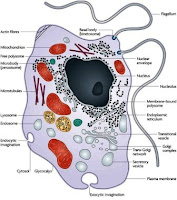The cell is the basic unit of
organization or structures of all living matter. Cell is the smallest portion of
an organism which exhibits range of properties of living beings like
reproduction, mutation, metabolism and sensitivity. Cell is defined
as “a unit of biological activity delimited by a semi permeable membrane and
capable of self reproduction in a medium free of other living
systems.”
The body of all living organisms
(bacteria, blue green algae, plants and animals) except viruses has cellular
organization and may contain one or many cells. The organisms with only one cell
in their body are called unicellular organism (e.g., bacteria, blue green
algae, some algae, protozoa etc). The organisms having many cells in their body
are called multicellular organisms (plants and animals).
Read more: Unicellular vs Multicellular Organism
Read more: Unicellular vs Multicellular Organism
There are two main classes of cells,
namely:
(A) Prokaryotic cell
(B) Eukaryotic cell
The terms prokaryotic and
eukaryotic were suggested by Hans Ris in the 1960’s. The
prokaryotes consists of the bacteria and blue green algae and were first to
arise in biological evolution (i.e., about 3 x 10 9 years old). The
eukaryotic cells are found in all multicellular animals, plants and fungi.
Eukaryotes have arisen probably a billion year after the prokaryotes and much
larger and complex. They show a wide range of diversity and
differentiation.
Difference Between:
Prokaryotic and Eukaryotic cell
No
|
Features
|
Prokaryotic Cell
|
Eukaryotic cell
|
||||
1 |
Occurrence
|
Prokaryotic
cells are the characteristics of bacteria and blue green algae
(cyanobacteria)
|
These
are cells are found in all, animals
and plants, except blue green algae and bacteria.
|
||||
2
|
Size
|
Mostly
1-10 μm
|
Mostly
10-100 μm
|
||||
3
|
Multicellular
forms
|
Rare
|
Common,
with extensive tissue formation
|
||||
4
|
Cell wall
|
Present
in most but not in all cells. In Bacteria, cell wall is made up of murein,
poly saccharides, lipids and proteins. Read more
|
The
animal cells lack cell wall, but plants cell wall is made up of cellulose and
chitinous cell wall is present in fungi. Read more
|
||||
5
|
Plasma membrane
|
Present
|
Present
|
||||
6
|
Nucleus
|
Absent.
Nucleiod region is present where genetic material resides.
|
Present
|
||||
7
|
Nuclear
Membranes
|
Absent
|
Present
|
||||
8
|
Chromatin
with histone
|
Absent
|
Present
|
||||
9
|
Number of chromosomes
|
Each
cell has only one chromosome.
|
Number
of chromosomes per cell depends upon the type of organism.
|
||||
10
|
Chromosome
|
The
chromosome is circular ring lacking a centromere.
|
Each
chromosome is linear having a centromere with two kinetochores meant for
attachment to the spindle fibres
during cell division.
|
||||
11
|
Genetic material
|
Circular
or linear, double stranded DNA: only exons are present
|
Linear
double stranded DNA: genes frequently interrupted by intron sequences,
especially in higher eukaryotes (called as split genes).
|
||||
12
|
Nucleoli
and Mitotic apparatus
|
Absent
|
Present
|
||||
13
|
Nucleolus
|
Absent
|
Present
(for the synthesis and organisation of ribosomes)
|
||||
14
|
Plasmids
|
Commonly
present
|
Rare
|
||||
15
|
Mesosomes
|
Mesosomes
perform the function of golgibodies and mitochondria, and also help in the
separation of chromosomes during cell division.
|
Absent
|
||||
16
|
Cell organelles
|
||||||
Mitochondria
|
Absent
|
Present
|
|||||
Endoplasmic Reticum
|
Absent
|
Present
|
|||||
Vacuoles
|
Absent
|
Present
|
|||||
Lysosomes
|
Absent
|
Present
|
|||||
Chloroplast
|
Absent
|
Present
(Only
in plants)
|
|||||
Centrioles
|
Absent
|
Present
(Absent
in higher plants)
|
|||||
Ribosomes
|
Only
70S type of ribosomes are present
which lie free in cytoplasm, or are engaged in protein synthesis.
|
The
cytoplasm has 80S type of
ribosomes; and plastid and mitochondria have 70 S type of ribosomes
|
|||||
Microtubules
|
Absent
|
Present
|
|||||
Flagellae
|
Simple
structure composed of the protein Flagellin. Read more
|
||||||
17
|
Respiration
|
Many
strict anaerobes
|
All
aerobic, but some facultative anaerobes by secondary modifications.
|
||||
18
|
Photosynthetic
Enzymes
|
Bound
to plasma membrane as composite chromatophores
|
Enzymes
packed in plastids bound by membrane
|
||||
19
|
Metabolic
Patterns
|
Great
Variations
|
All
share cytochrome electron transport chains, Krebs cycle oxidation,
Embden-Meyerhof glucose metabolism or glycolysis.
|
||||
20
|
Sexual
System
|
Rare:
If present one way (and usually forming partial diploids or merozygotes);
transfer of DNA from donor to recipient cell occurs (conjugation). Gene
transfer takes place by transformation and transduction also.
|
Both
sexes involved in sexual participation and entire genomes transferred;
alternation of haploid and diploid generations is also evident.
|
||||
21
|
Cyclosis
|
There
are no streaming movements of cytoplasm
|
Cytoplasm
shows streaming movements
|
||||
22
|
Protein
Synthesis
|
Transcription
and translation take place in cytoplasm.
|
Transcription
occurs in nucleus and translation takes place in cytoplasm.
|
||||
23
|
Duration
of cell cycle
|
Cell
cycle is short, takes 20-60 minutes to complete.
|
Cell
cycle is long, takes 12-24 hours to complete.
| ||||


Comments
Post a Comment